TRUNK
Debut Solo Show - Gallery Sally Dan-Cuthbert - October 21 to November 21 2021
Exhibition Essay and Photos by Emma Pegrum
Full Catalogue available at Gallery Sally Dan-Cuthbert
Catalogue Photos by Lajos Varga
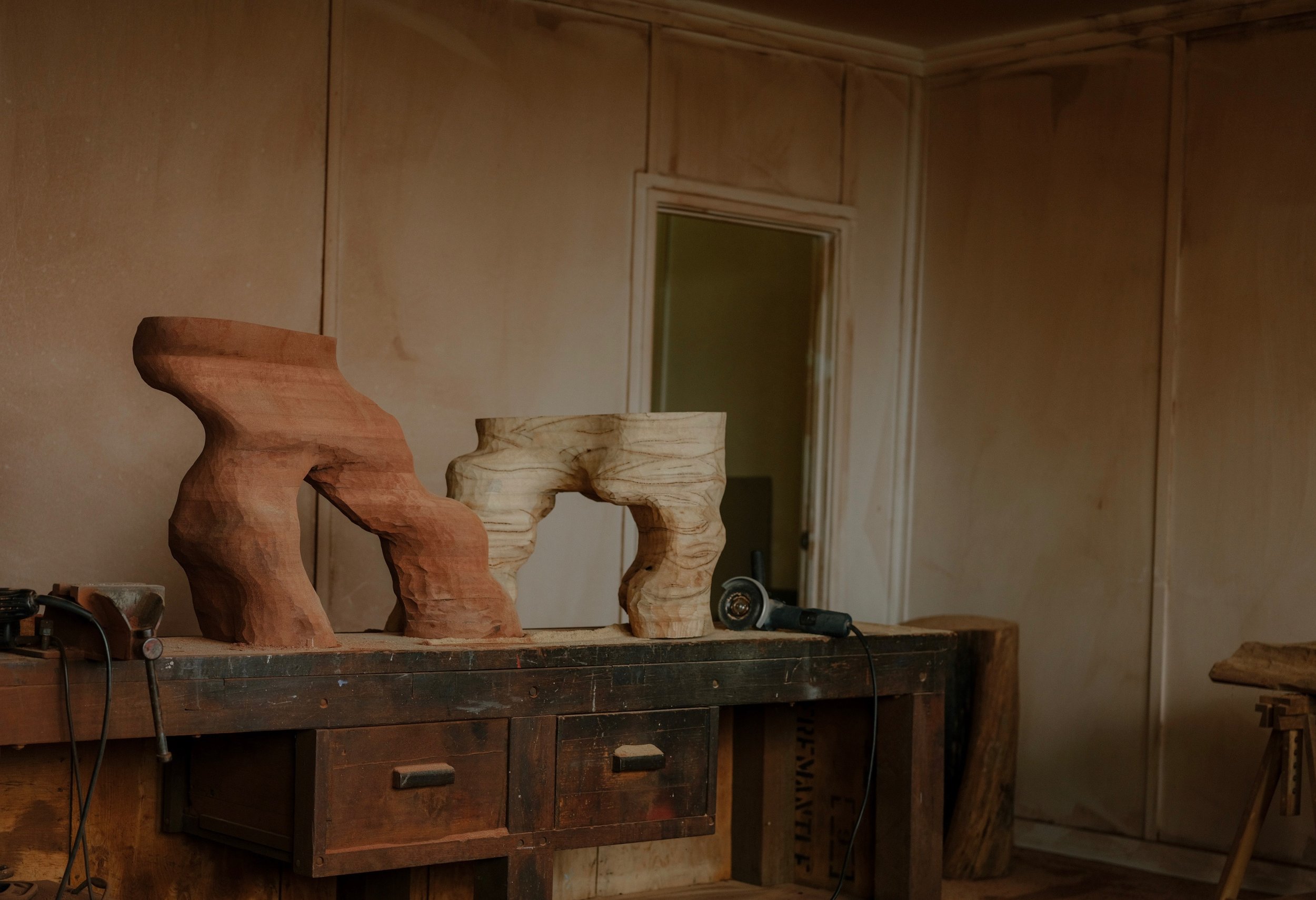
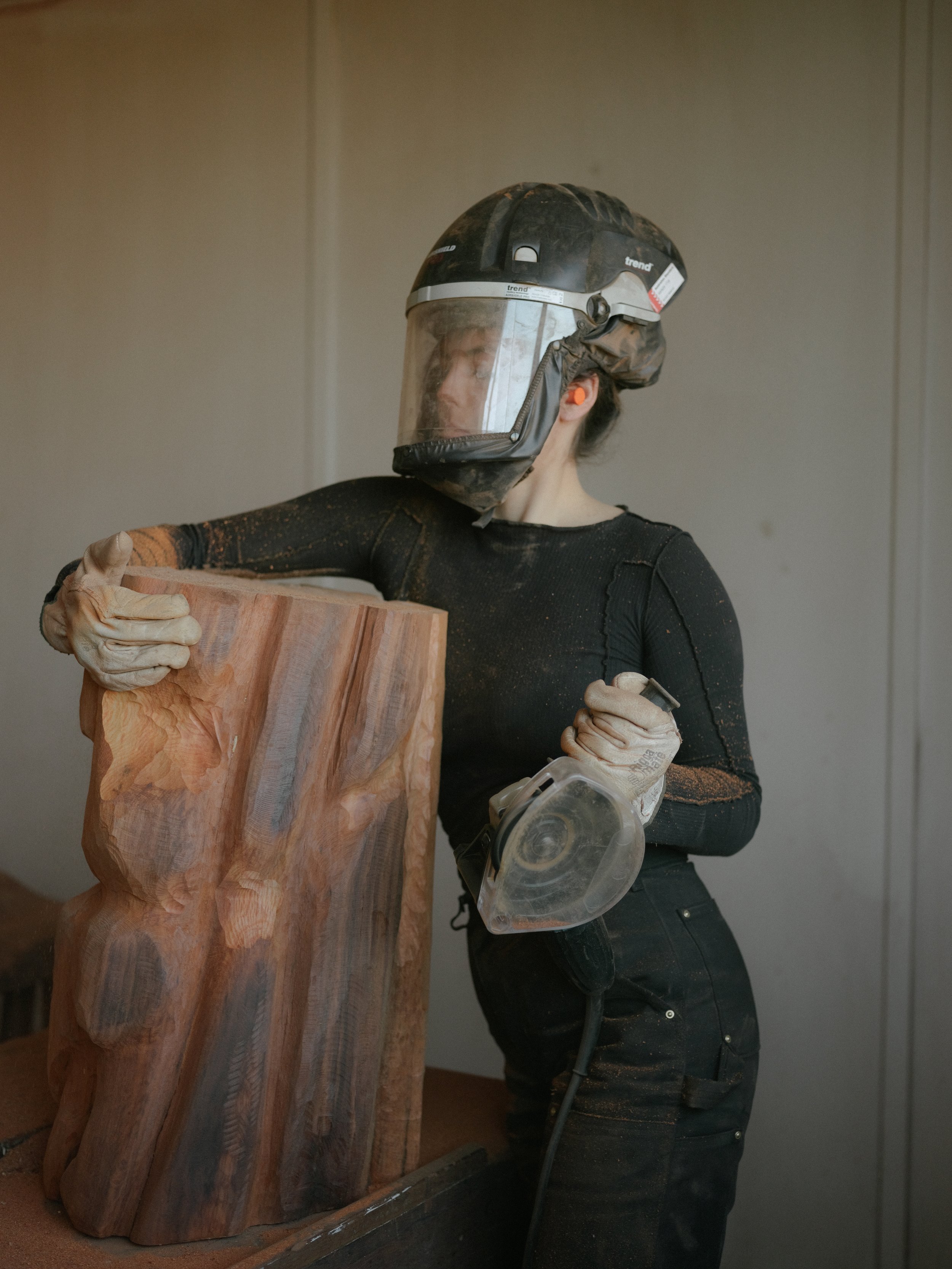

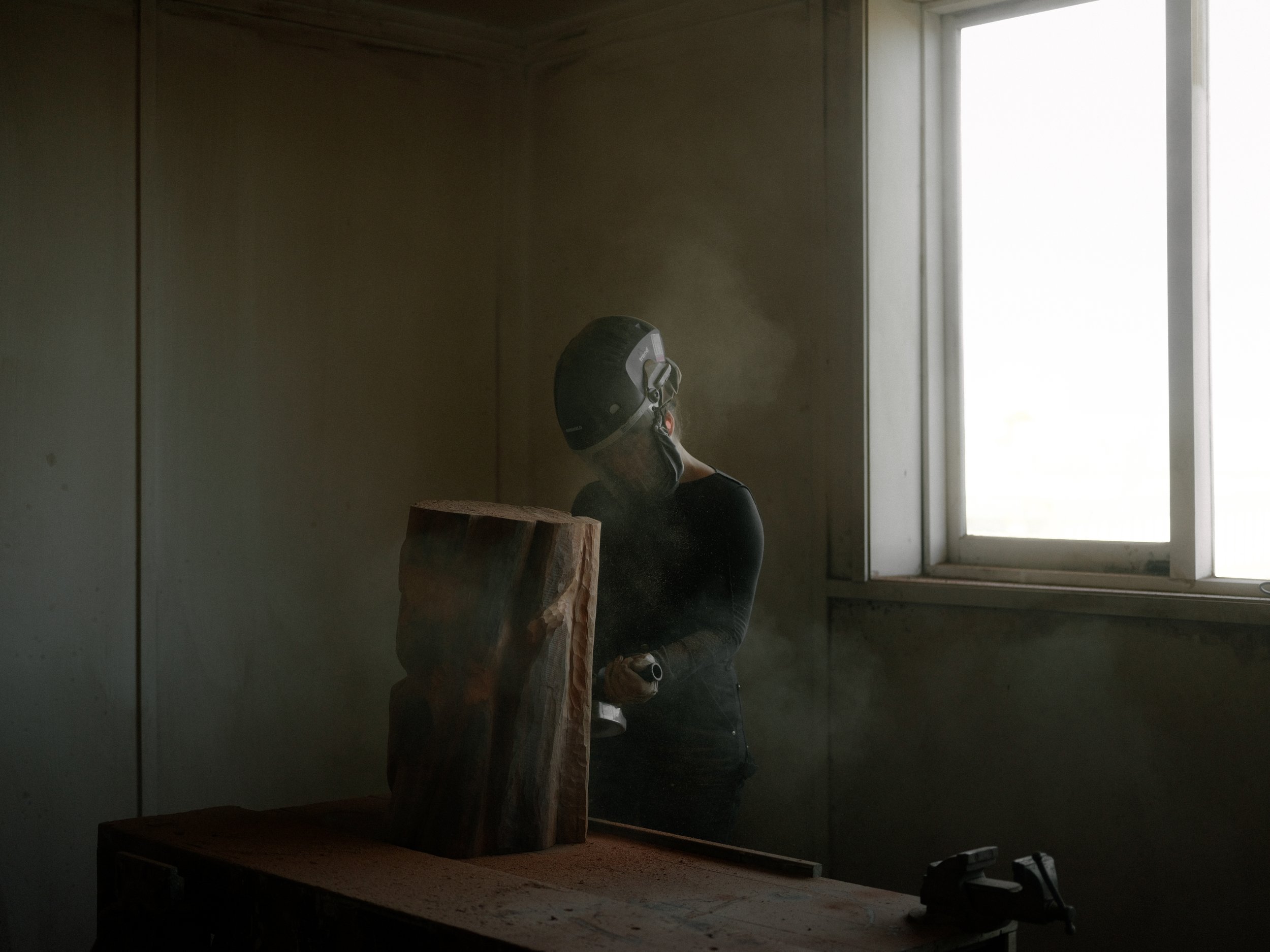
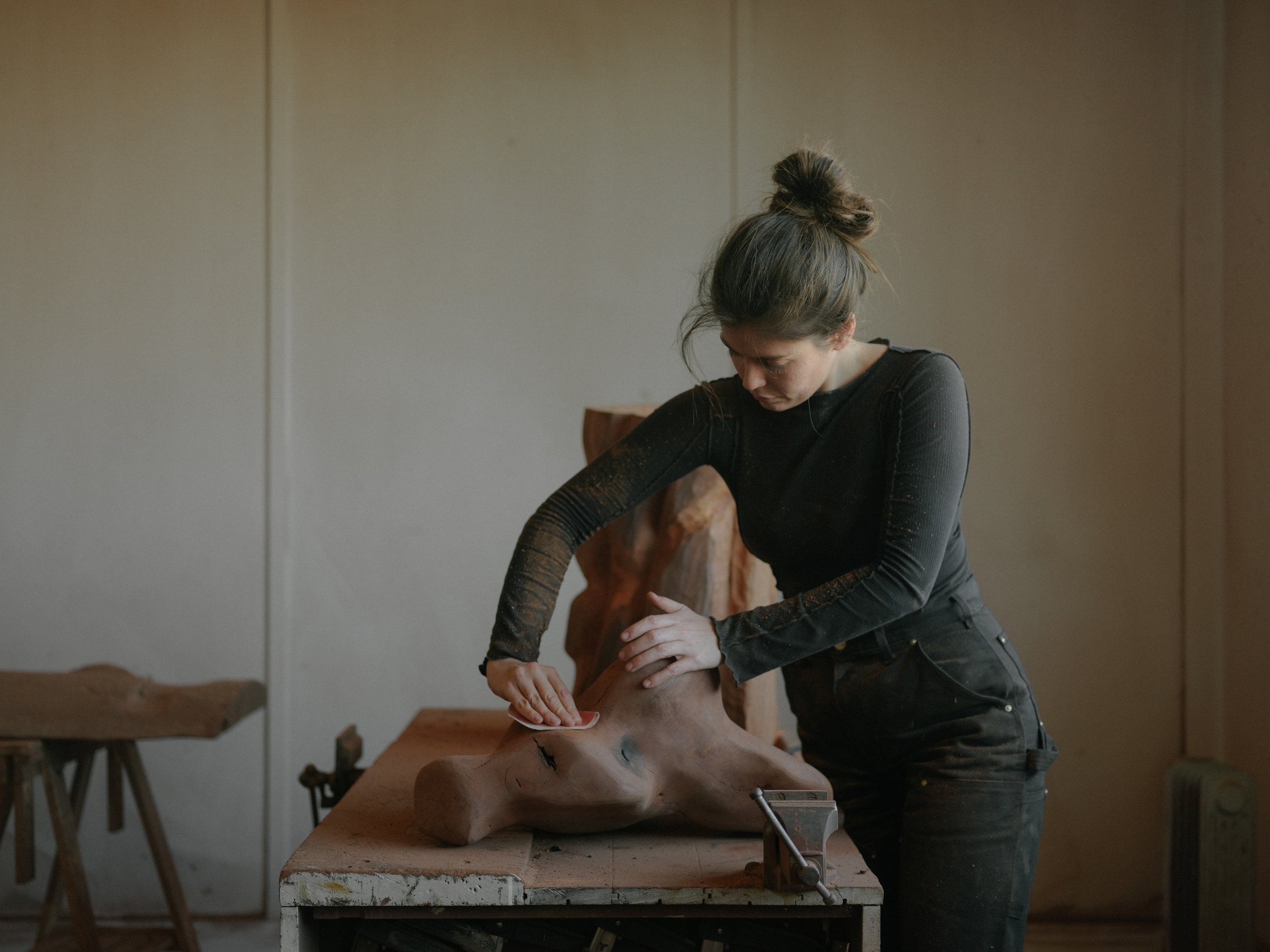
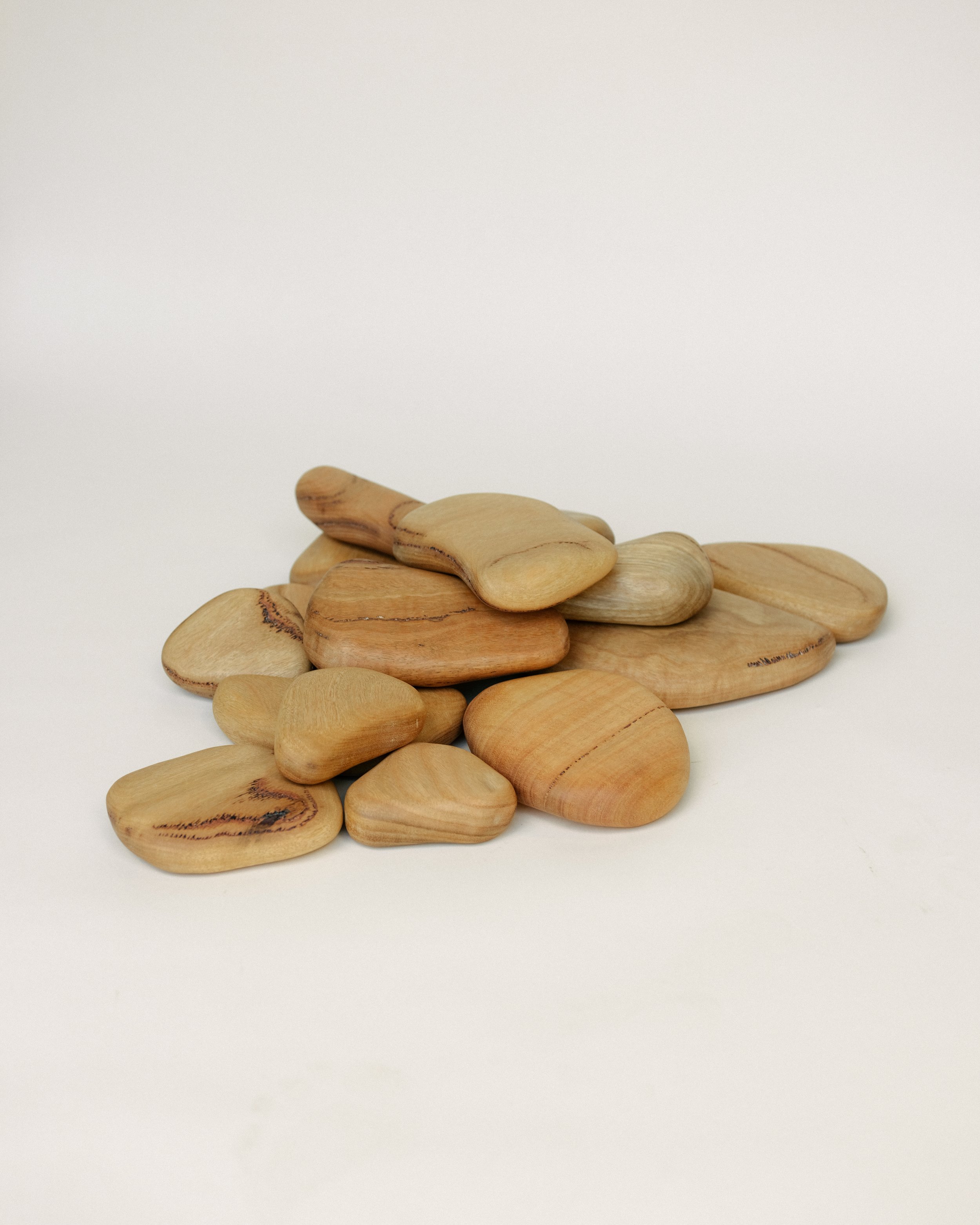
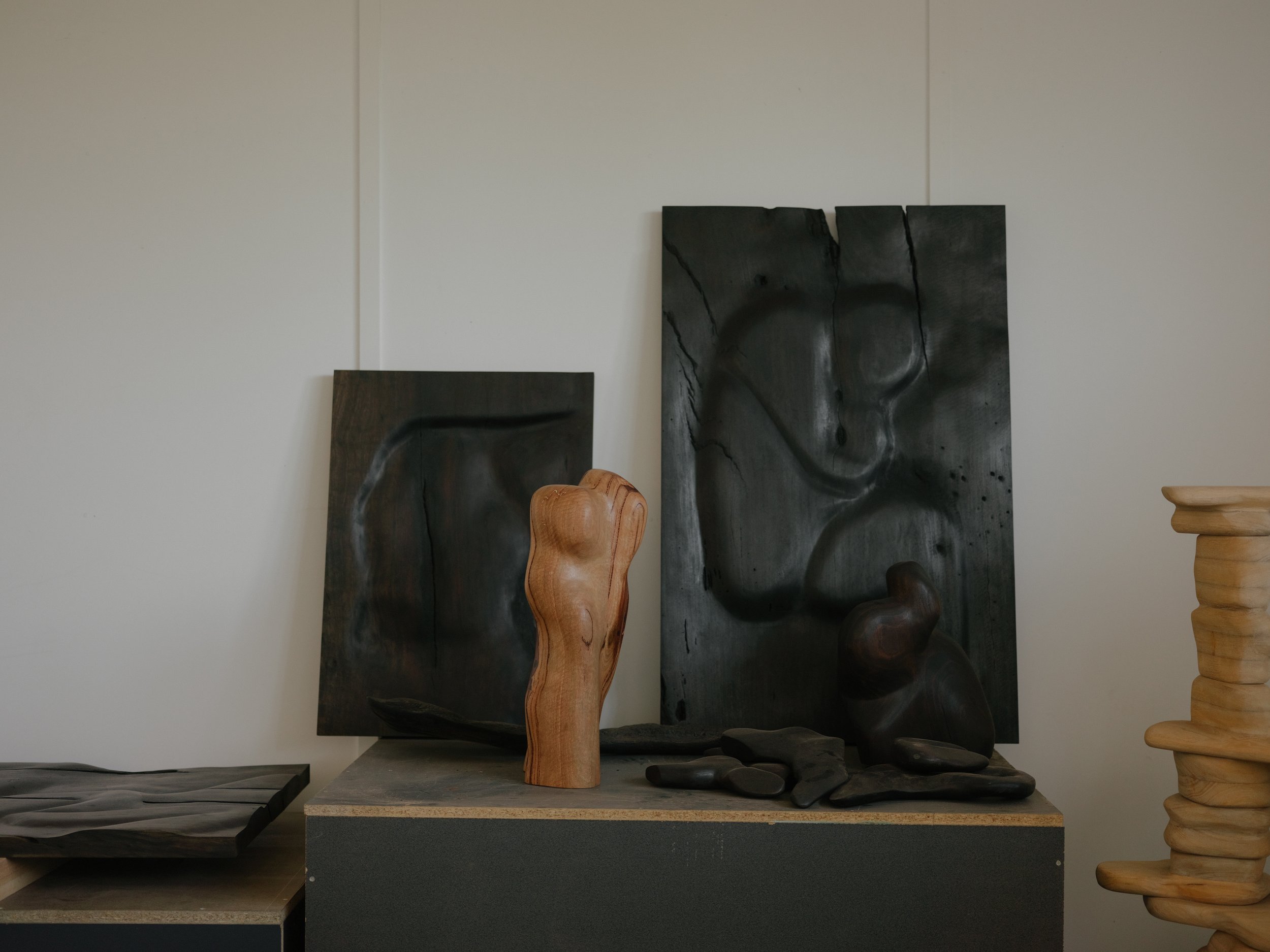
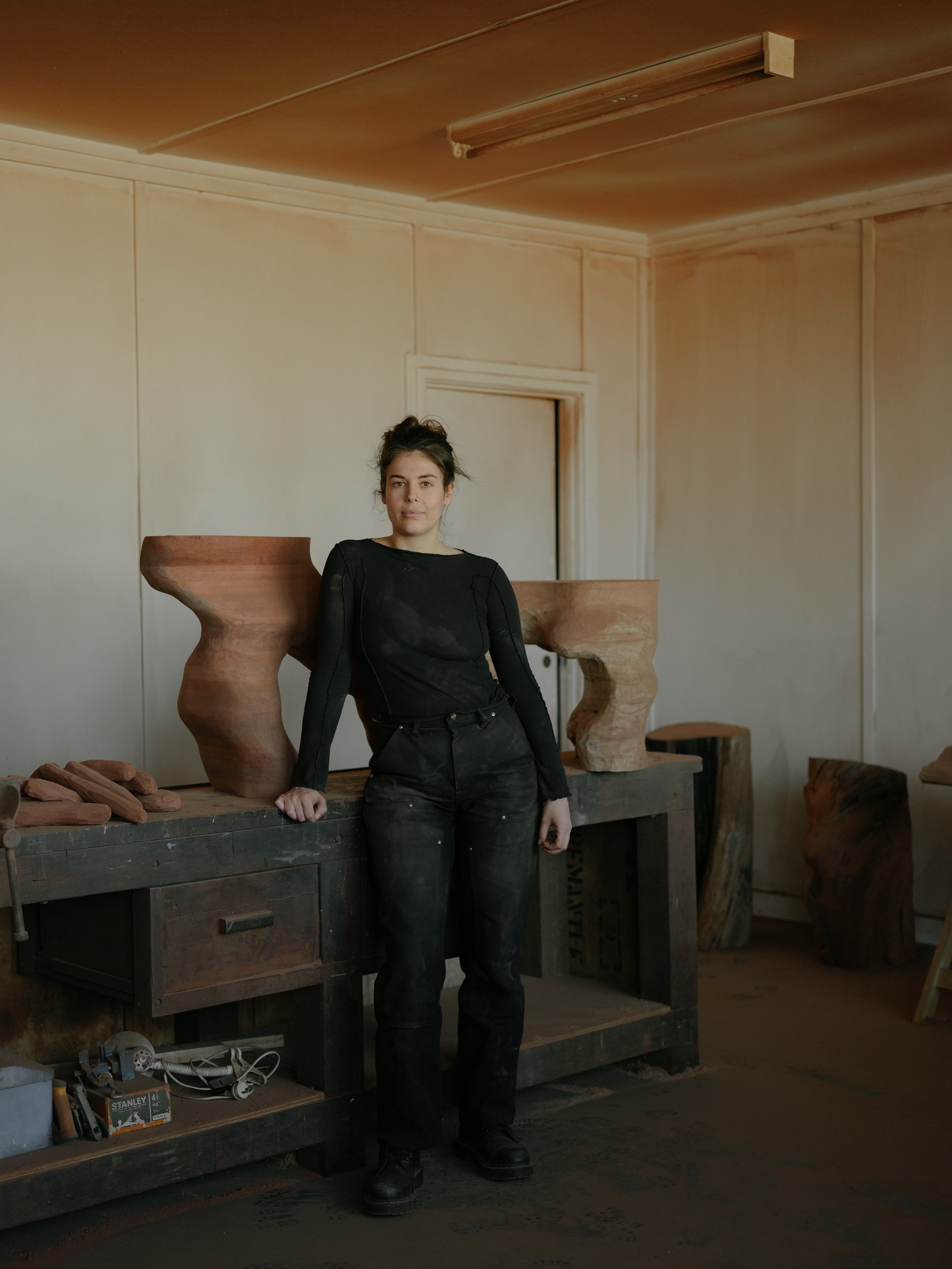
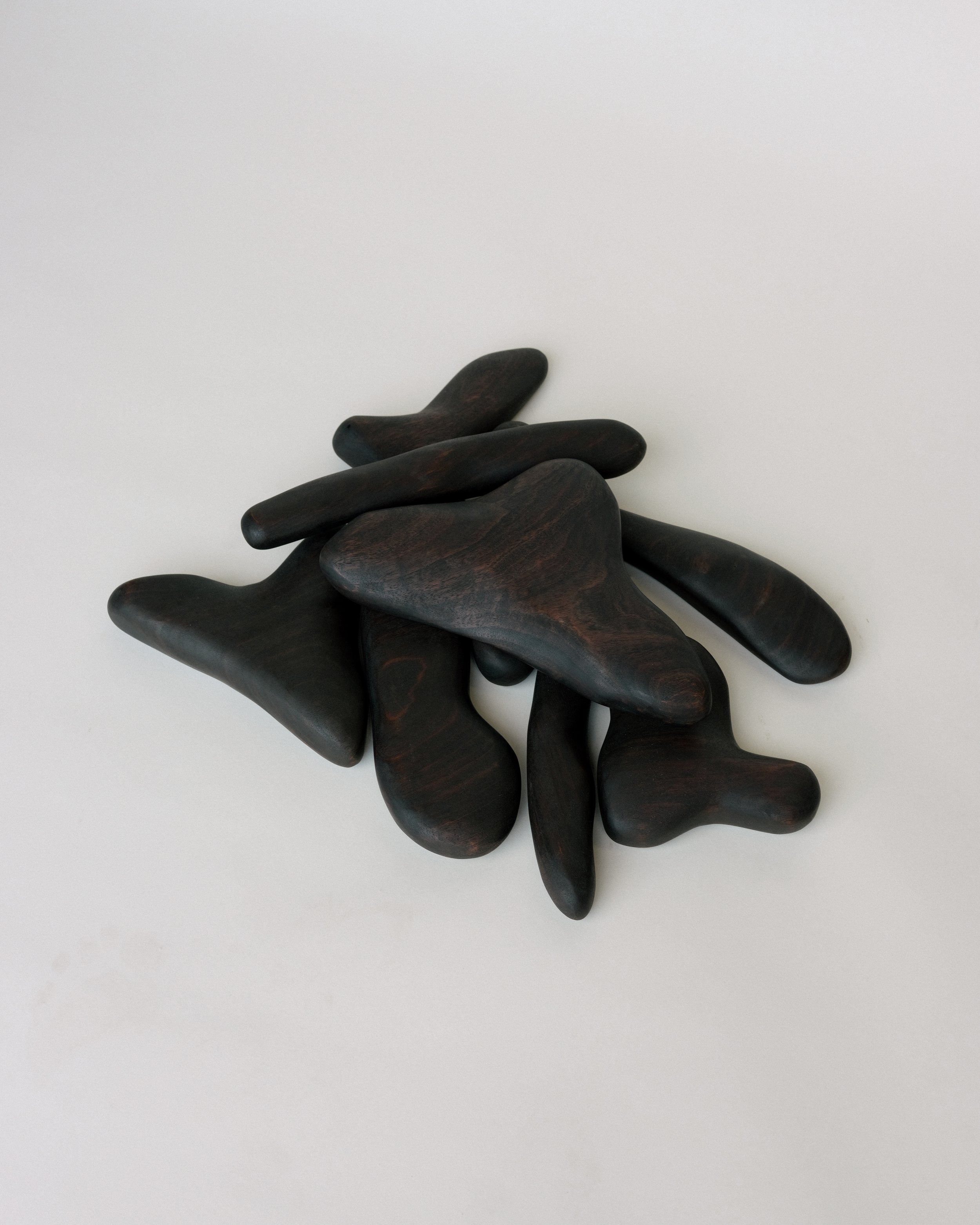
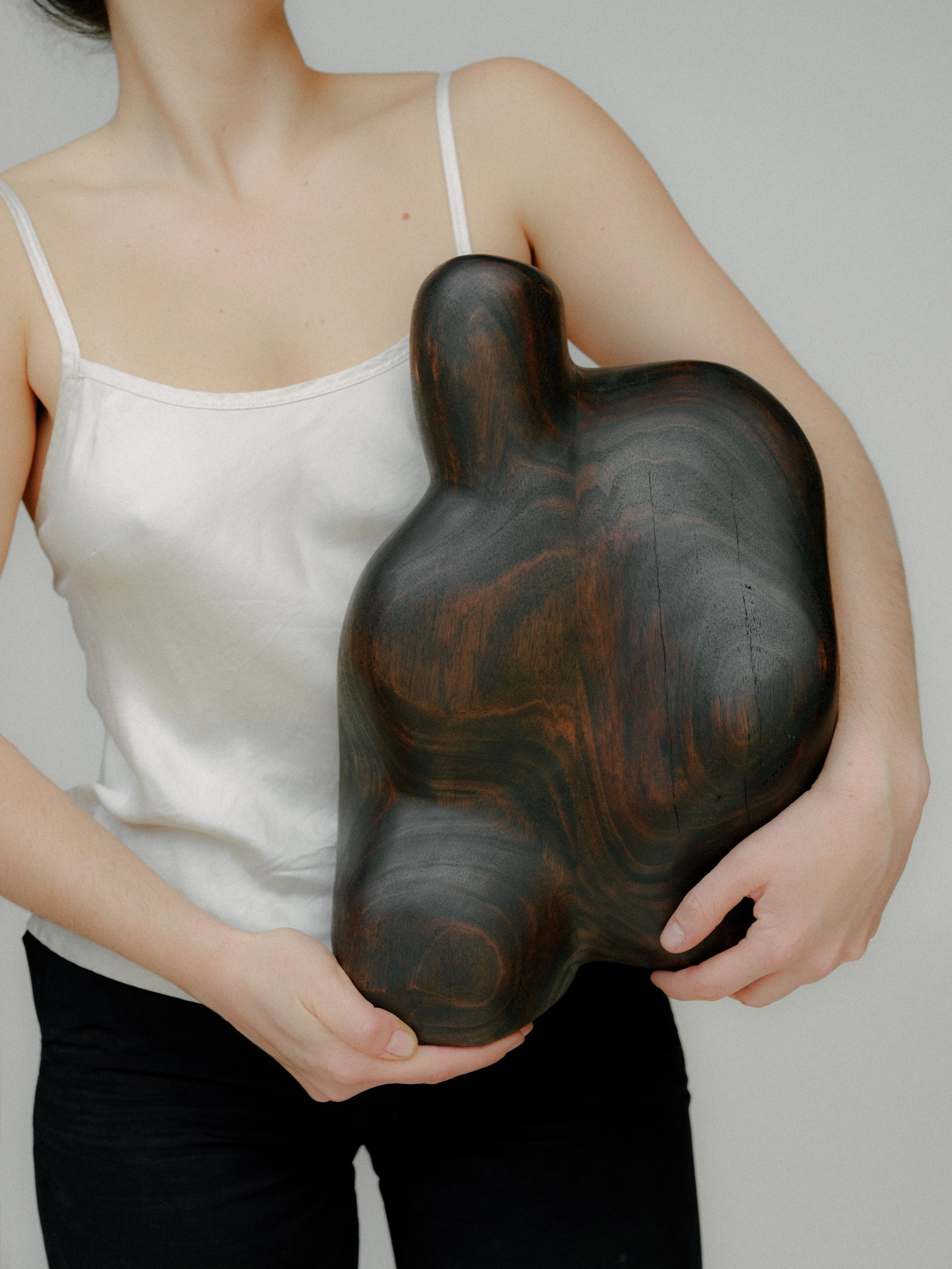
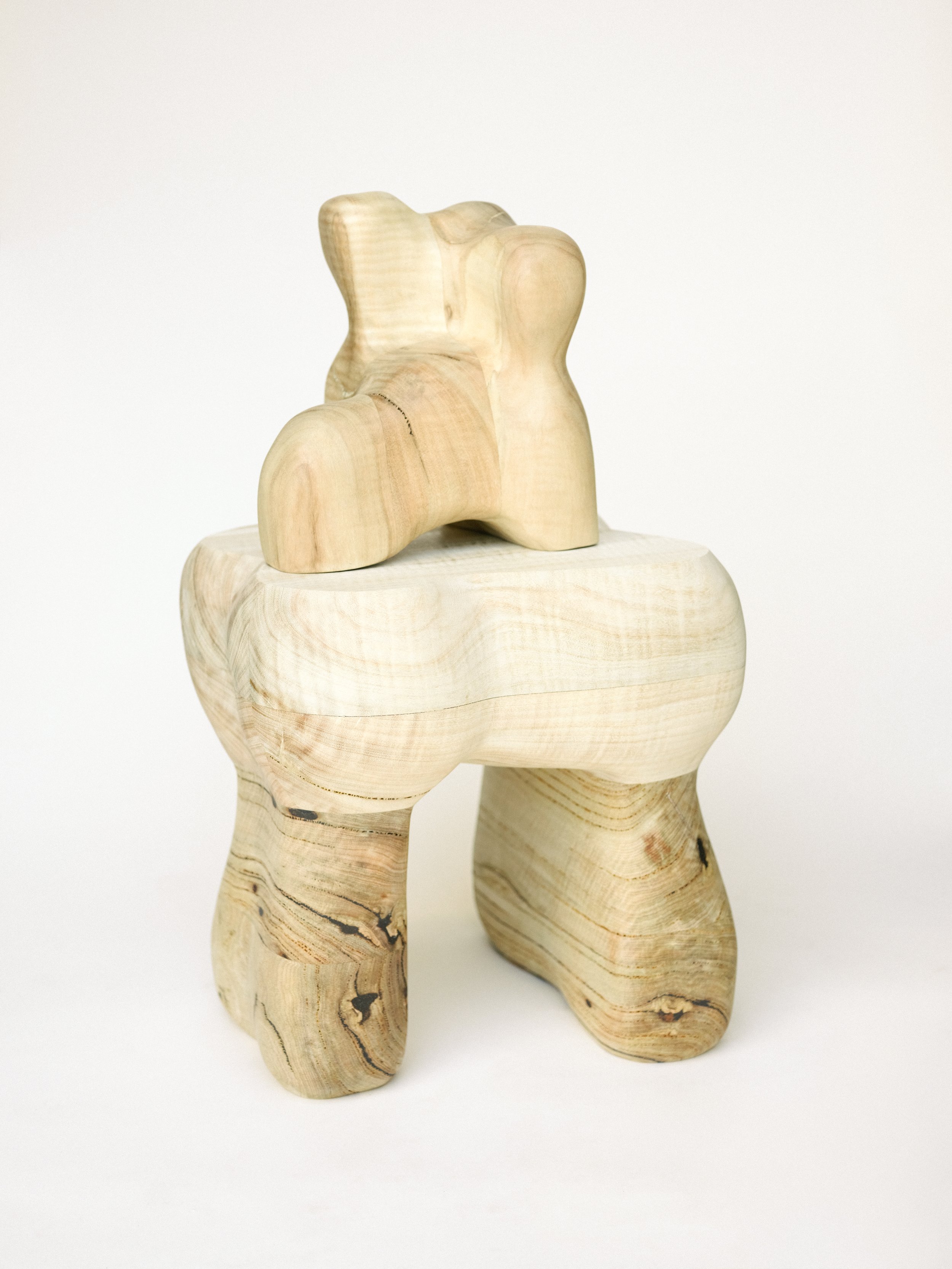
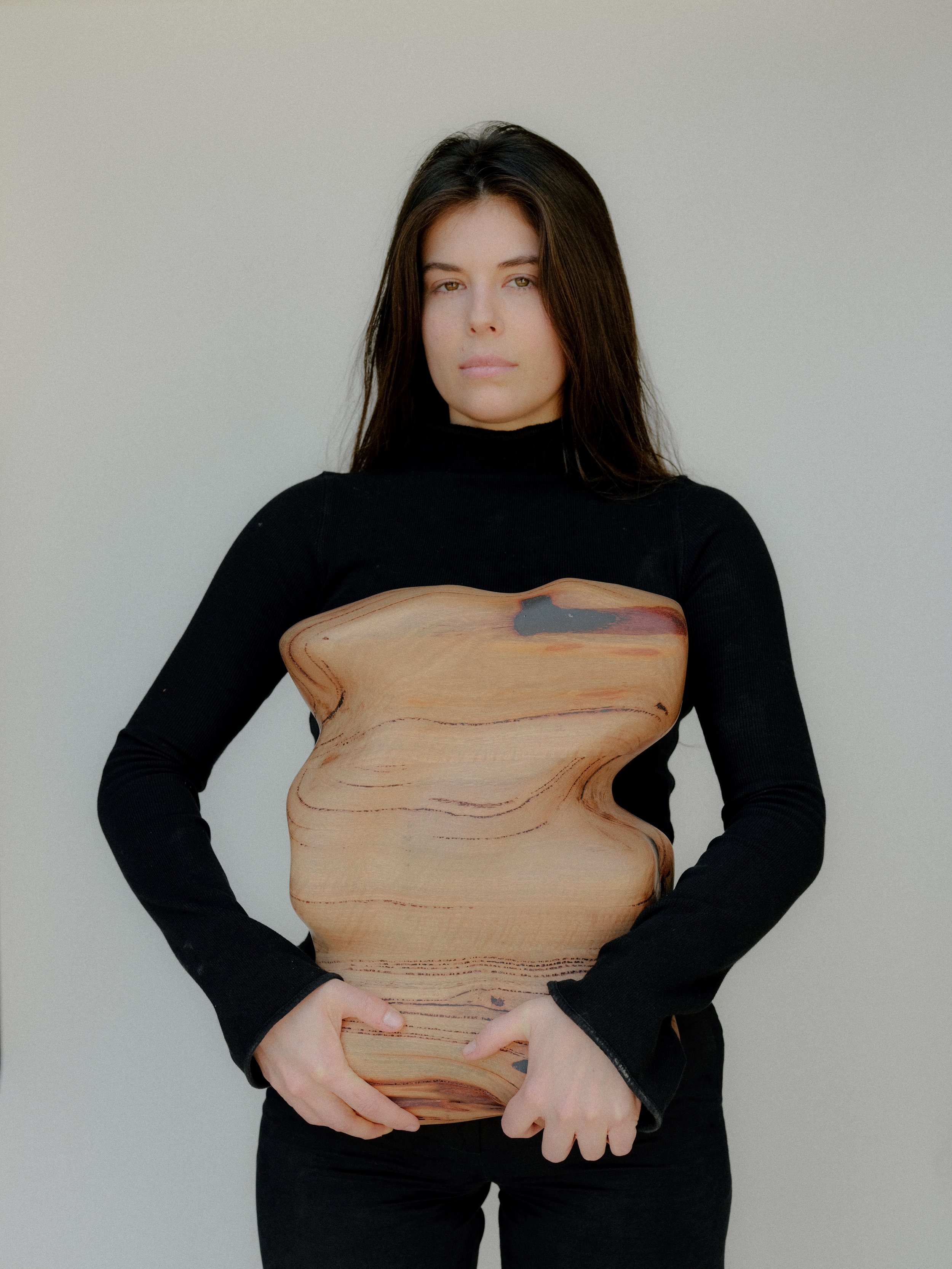
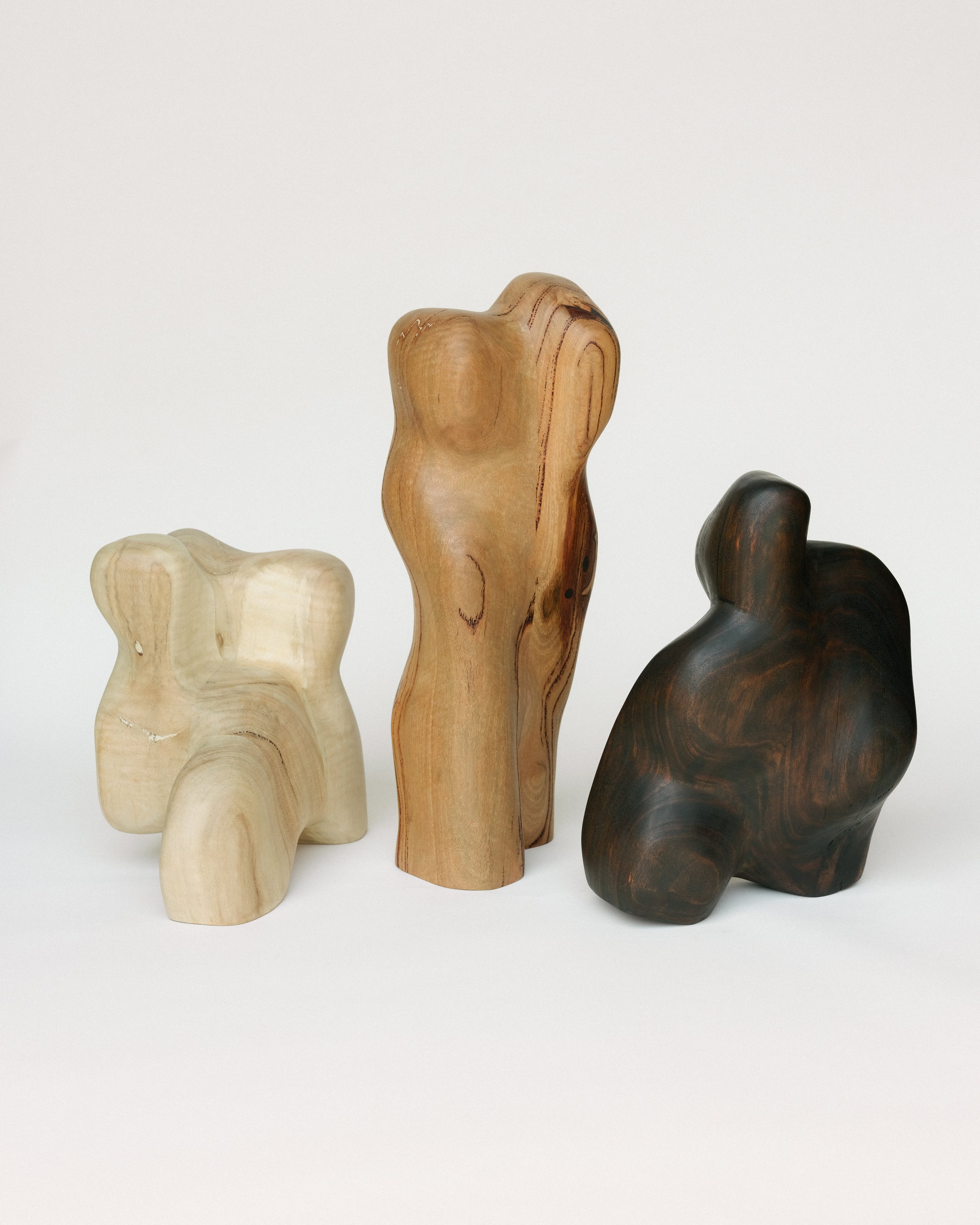
The embodied objects of Olive Gill-Hille’s “Trunk”
By Emma Pegrum
The complex capacities of material objects both quotidian and artistic have long occupied modern thinking. Objects often stem from us, and even in their physical separatism continue to relate to us, or us to them; they become part of us and vice versa. Such well-trodden thinking is wrought anew in Olive Gill-Hille’s debut solo exhibition Trunk, which gives shape to the relationships between objects, bodies and their environment.
This showcase of handmade wooden objects comprises both functional artworks and figurative sculptures; the former defined as having—at a minimum—a surface on which a human or another object might rest, the latter existing more entirely in their own right. Yet, each piece pulls equally at the viewer. The patterns in the wood itself ask to be traced by the human finger; the curves and accentuations of the objects request the attention of the palm.
In its inclusion of sculpture, Trunk marks a maturation in Gill-Hille’s practice from her earlier student work more obviously resembling furniture. There is a clear obtaining of creative liberty here to make objects purely for their evocative value rather than prioritising their relevance to human use—or even requiring that usefulness to facilitate, that is, to give parameters to, making. Her departure from more functional to more figurative forms also opens the work to new readings, new modes of understanding how it relates to human existence. These are embodied objects in that they engage the viewer beyond their status as a user; they transcend the cognitive and begin to tug at the visceral.
Often beginning with drawings and watercolours of concepts and designs, Gill-Hille’s process is entirely manual and independent—from the collection of the raw material and its processing and dressing, to the milling and gluing and finally the shaping, carving, sanding and finishing of each work. The work presented here is all Western Australian Marri and Jarrah, with some Sheoak.
By virtue of Gill-Hille’s use of timber, and the prevalence of organic, bodily shapes in the finished objects, there are intuitive and visible parallels in the work between tree trunks and human trunks, or torsos—as declared in the exhibition title. There is a strength required in wrangling wood and using the requisite machinery and equipment that brings the artist’s own physical structure into acute focus. Importantly, this is amplified by that structure’s femininity; shapes of the feminine are reclaimed in these works, which are in dialogue with the modernist sculptures of men artists like Constantin Brâncuși, Isamu Noguchi and Jean (Hans) Arp. They are as such not only objects unto which the viewer might project, but extensions of the artist in the first instance; they embody her physical and emotional self.
It follows, then, that the works are existential, and notions of dying and living pervade Trunk. This is most immediately true in that the work, being of wood, both confronts and is confronted by environmental degradation. But it also responds to human lifecycles: the period of time in which they were created coincided with the gradual decline in health of Gill-Hille’s father, the beguiling Perth painter and publican Murray Gill, who eventually came to rest in May this year.
Visually, these different influences on the work are manifest in form, colour and function. The shapes present are familiar but they are also re-examined; provocative. Light wood and dark wood, the latter imbued either by fire or through a natural ebonising finish, sit together in both opposition and harmony. Some of the works achieve their purpose only in the placing together of multiple parts, conjuring ideas of support, dependence and physical intimacy. Taken as a whole, the works constitute and occupy a world of their own. But this world is in constant and meaningful contact with ours. These embodied objects meet us, they prompt us to reflect on the corporeal conditions of our existence, and on the social and cultural meanings, impacts, limits and potentialities of the human.
DYING
The timber with which Gill-Hille works is dead. When trees are alive, they are—like humans—full of oxygen and moisture. When a tree dies, there is a drawn out exhalation of that moisture until it self-converts—often with the aid of milling—into a dry material. Where raw wood dictates its handler, timber is a stable, workable material. But it is not static. Gill- Hille commonly opts for intuitive carving in preference to using jigs, responding to and retaining the inherent qualities and the will of the timber in each work’s ultimate form. In so doing, she acknowledges the life beyond death of the wood; she works to extend its life via an object worthy of embodying the original majesty of the tree.
Contending with the ethics of timber use in an increasingly vulnerable ecosystem— particularly for art making—is central to Gill-Hille’s work. She sources fallen or burnt trees, sometimes also felling badly diseased or dying trees, from the rural properties of family and friends. “I use the timber that is accessible to me,” Gill-Hille says. “The old growth trees are dying, and I'm making work out of these dying trees because that’s what’s there. I'm using a material that's plentiful at the moment, in a way.” It’s an uncomfortable irony reflected in the tension of the finished works, but also a realism that provokes an obligation to the material, an obligation to make work that has a place, is worthwhile.
“It's not necessarily a greater statement on climate change as a whole, even though that's obviously there. I’m making work from dead things, but [...] it’s dead and alive. Timber is dead, but it’s somehow also a living object; it splits, it moves, it reacts to weather, it reacts to humidity. [My work is] about extending the life of that bit of material. I do feel a responsibility to the timber.”
Spending a lot of time in the south west, Gill-Hille says she’s “witnessing” the sickness of the forests and trees, and her work is a kind of homage to their valuable place in our lives, an attempt to preserve their wondrousness, to embody the life of the material within a forever-object.
This “witnessing” of sickness and death is mirrored in Gill-Hille’s experience of her father’s decay while making the Trunk works, the concomitant timing of which naturally imbues the objects with a darkness, or sadness, but also with great affection and warmth. During the end of her father’s life, Gill-Hille went from studio to hospital and back again for months, visiting and helping him in palliative care, her own physicality and strength in making the work amplified by her dad’s immobility.
Reflecting on these contrasting experiences, she pays particular attention to human function, as opposed to emotion:
“Using my body was a big part of [making this work], and my dad was very much not using his body. He couldn't use his body anymore, basically. And then eventually he couldn't talk. He really lost all ability, he couldn't walk by himself the last year of his life. And then he couldn't even sit up. I was coming in from making this work that was very physical and very heavy and then going in to see my dad where he couldn’t even feed himself properly. That was obviously jarring for me.”
It is the work that contains the artist’s emotional weight. This is most obvious in the series of untitled burnt works, in which the use of fire to manipulate the material embodies her catharsis. It also manifests in the darker pieces, which are Jarrah pieces Gill-Hille finishes with an eboniser she brews from scratch with white vinegar, rusty nails and steel wool.
Her materials and processes are harsh and brutal, in contrast to the elegance of her resulting pieces, which are the product of much artistic wrestling. This process imbues the work with a palpable tension—the wrestling is an act of love that seems to channel both care for the material and the complicated emotional state of child caring for parent.
The objects, thus, contain as trunks the memory and history and complexities of the timber from which they’re made as well as that of the relationship between father and daughter. In this way they remain resolved objects; their embodiment of and appeal to not merely the human form but human experience makes them whole.
There is of course a direct relationship between the works and the artist’s body in the handling of the material and objects throughout their creation that also begets their embodiment. When carrying or moving the works, Gill-Hille comments on how they feel like her babies or children: this makes sense both on a practical level in that she produces them so laboriously (they are extensions of her), and on a more sentient one, in that they embody her own complexities. The works thus take on a range of capacities, or a certain dynamism, in the process of being made.
“I feel close to the timber, I do actually feel like [the material] is me when I'm working with it, because the work is very bodily, it's very physical,” says Gill-Hille. “It does feel like I'm putting a bit of me into each work with that physicality.”
This subject-object connection is most visible in Trunk and Torso, in both of which the human form is rendered distinct, literal. Similarly, Gill-Hille’s Figures Revisited— refinements of her popular figure stools, reworked in Marri for this showcase—call directly to the human body both in that they provide a seat and in that their shape emulates the bottoms that sit upon them.
Gill-Hille also speaks of the capacity of the works to break down her awareness of self into parts. This is manifest in Parts, an artwork made up of small, co-dependent objects that intuitively mimic the shapes of her own individual body parts or bones; it resembles a pile of bones, again referencing mortality and yet also warmly attentive to the aliveness of bodies, to their make-up. “They are self-portraits, in a way,” Gill-Hille says. “They were made to feel like parts of my own body. It’s me making what I know.” Often it is when we are broken down to our parts—whether through emotional turmoil, or suffering, or decay— that the beautiful function and form of our bodies emerges most clearly.
Such heightened awareness of the body’s intricacies is certainly cognitive in a sense, but arises more urgently through the intuitive experience of using and thus discovering one’s body. This sensation is firmly historicised, rooted in the thinking of Maurice Merleau-Ponty, a seminal 20th century philosopher whose work largely founded modern phenomenology and existentialism. Merleau-Ponty conceptualised the self as its own first embodied object: as being the object through which we discover ourselves as a subject, and through which we then perceive and experience all that is. This is summarised in his famous “hand experiment”, of which he writes in his 1960 text Signs:
“When my right hand touches my left, I am aware of it as a ‘physical thing’. But at the same moment, if I wish, an extraordinary event takes place: here is my left hand as well starting to perceive my right [...] The physical thing becomes animate [...] Thus I touch myself touching: my body accomplishes a sort of reflection.”i
This sentience of the hands is a feeling with which Gill-Hille became deeply familiar in the making of Trunk. “I came to feel very connected to my hands,” she says. “I think being able to use my hands in this way is special. It’s valuable.” Particularly in her intuitive carving and in the process of hand-sanding, Gill-Hille discovers her hands anew, as did Merleau- Ponty all those decades ago.
Her hands also came to embody the concurrent activities of making the work and caring for her father. “Definitely there were times where [...] something physically felt similar, working with the wood and helping Dad. Handling him and handling the work,” she says.
In this way, her hands become portals for the transfer of embodied experiences between maker, object and viewer, and by extension out into the worlds they occupy. This marries with how Merleau-Ponty and his contemporaries came to understand embodiment: as a descriptor of human perception not as purely cognitive but as something experienced through our living bodies.
It’s through such nuanced processes of emergence that both material “objects” and human “subjects” come into being. Trunk brings this into renewed focus, reminding us that we do not simply act upon inert matter, but are acted upon—we are living through that which surrounds us, that which happens to us, that which we confront.
LIVING
When read this way, Trunk is not so much about death as about life, aliveness. This is not only true in Gill-Hille’s intention that the works extend the life of dead material, but in the more subtle truth that the objects are both self-affirming for the artist and have the capacity to confirm and enrich the existence of the viewer.
The capacity of objects to live in such a way is explored in Ruth Bielfeldt’s essay for Art History’s June 2018 special edition The Embodied Object in Classical Antiquity, in which she writes:
“External objects too [...] are part of bodily sensations. They actively provoke them: objects have the capacity to turn from something touched into something that is experienced as actively touching and provoking a sensation.”ii
She goes as far as to necessitate objects for understanding of the self, writing in response to Merleau-Ponty’s experiment that humans “need more than just their hands or feet to experience themselves as bodies within the world” and that they “require the presence of objects that redirect touch towards them”.iii
The works in Trunk achieve this for the viewer. Read even at their most passive, they are incredibly textural, they invite contact. “The works are very tactile, they're very much meant to be felt and touched,” Gill-Hille says.
But beyond this, the works have enormous agency. They ask us what we can do with them, challenge us to figure out what they are for—or at the very least, they suggest they’re for something. That is to say, they’re suggestive in form. This is particularly true in Grind, a two-piece occasion table referencing sex and intimacy—the two tables are rugged-legged and sit pushed up into each other, entwined. Or in Move and Trunk, which both gesture at something beyond themselves, as if dancing. They almost look like they could get up and walk away, are already walking. They are solitary, self-ruling.
The presence of such self-embodied characteristics is rooted in Gill-Hille’s desire to carve out a distinct artistic identity. The shapes she’s working with—inspired by the female form—are not radical, as they once were when employed by her mostly male artistic influences in modernist sculpture. But Gill-Hille is part of a canon of women artists who work with these shapes as an act of repossession. “There is something appropriating about [men’s] use of those shapes. So there’s definitely something in [Trunk] about a woman making these shapes—reclaiming them,” she says.
She is empowered through her re-contextualisation of a typically male-dominated medium (modernist sculpture), as well as through her acquisition of typically male- dominated skills in woodwork and furniture making. When studying furniture design at RMIT, she relished in being one of few women in the workshop learning how to use heavy equipment, timber and tools, and wielding them for her own artistic purposes.
“I really enjoyed that course, I loved it. I worked really hard during that time. It was predominantly men in the course, and the lecturers were all men apart from one woman. Everyone was making furniture, but I wanted to do things differently. They didn't always get what I was doing,” she laughs, “but they empowered me to make.”
“It was exciting. I definitely wanted to make a statement as a woman making furniture. I wanted to make pieces [in which it] was very obvious a woman made it.”
Gill-Hille holds on to this sense of delight in carving out one’s place in life, even as hers played out against the loss of her father, or perhaps especially so. She speaks guiltily of savouring her aliveness in contrast to her father’s decay; of being with him and feeling pulled back to her studio, her partner, her own expanding world. This is human, as many will know—it is the silver lining of death that it can enliven those who remain, that the dying crystallises the living.
Trunk thus contains the joys—the heightened emotion—experienced in times of grief as much as the sorrows. “There is a lot of darkness in the work, but there’s also lightness. There is relief. There’ve been really great times in the past few years, some of my happiest moments—as well as that really awful grief.” In a kind of symbiotic beauty, and as is so often true, her father’s death made room for her aliveness and that of her work.
Despite Gill-Hille’s evident struggle for self-embodiment, there is also surrender present in Trunk. The works are as quiet, warm and inviting as they are strong and independent. Consider Spoon, in which one piece of supple dark wood rests upon another to form the whole object. It draws you in to caress and be caressed. It contains and offers great solace. In this way, the works fall further into parallel with real living bodies, which can also be at once warm and soft, and hard, perplexing, sovereign.
The delicacy and the power of these objects is enticing not only because these contrasts evoke curiosity, but because they reflect to us tensions within ourselves. The works embody our ever-conflicting desires to move and to rest, to be held and to be autonomous, to love and make love and to resent and make war, to latch on and to let go.
In this way, Gill-Hille’s works take their value not from the storied trees or the arduous process through which they are made, not from their function or usefulness, and not from their elegance or beauty—though all of these things imbue worth, and make the objects the timeless pieces they are. But the true substance of the works lies in their ability to probe at the visceral limitations and possibilities and joys of being human; to press back on us as we touch them and remind us we are alive.
————
i ‘The Philosopher and his Shadow’, Merleau-Ponty, M. (1964). Signs (p. 166). Northwestern University Press. ii Bielfeldt, R. (2018). Candelabrus and Trimalchio: Embodied Histories of Roman Lampstands and their Slaves. Art History, 41(3), 420-443.
iii Bielfeldt, R. (2018)
